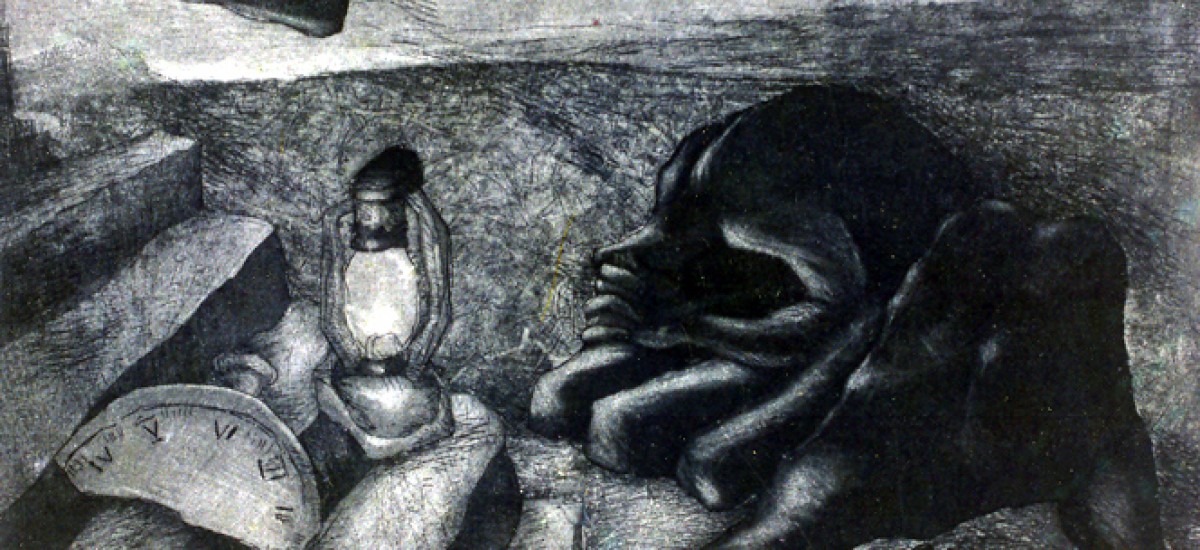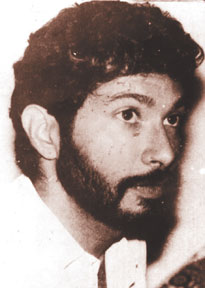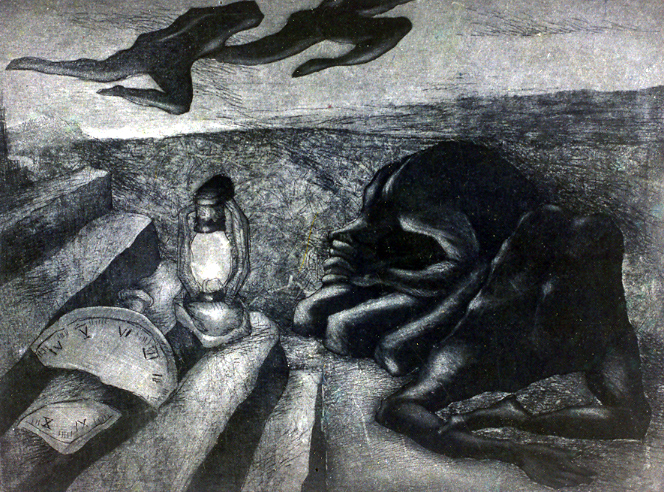cc: Ravi, Priya, fighters both, taken before their time.
Three pictures hang in my study. (Not my study actually, contractually; the bank retains the mortgage. I do not write in, from a room of my own. Besides: designed, constructed, lived in by others, their trace lingers upon this space.)
The first picture: a photograph of the young, handsome, meticulously coifed Richard Manic – Manic, not manic – de Zoysa, of his face – an image that still bruises, incites me – off the web, the Daily News if memory serves, framed together with (a typewritten copy of) a poem, For Richard, (signed) by Arjuna Parakrama, dated February 1990, which I received through the (snail) mail.
At the risk of reading my own prose, that sentence, with its many qualifiers, interruptions, draws attention, as far as I can tell, to: affect; the products of old and new technology on the same surface (like in Jagath Weerasinghe’s painting, Armoury, the second image); Richard’s pedigree – one namesake, uncle ‘Dickie’ de Zoysa, was S. W. R. D. Bandaranaike’s best man, the second, grandfather Manicasothy Saravanamuttu, a diplomat whose father was Bandaranaike’s doctor; state terror; the incongruity of taking an image from state media to commemorate a close friend I miss, twenty-five years later, one murdered by that state (but then Richard worked with Rupavahini, not to mention propagandized with military intelligence, before switching allegiance to the JVP – both, however, linked by association with Sinhala nationalism); the reliability, rends of memory; the irony in the title – written for someone who cannot receive it; Arjuna’s signature, dedication “For Qadri,” prompting wonder if the poem is for more than one person, an offering to the living, too – in which case the preposition in its title, as does my framing, would signify in place of, substitute; the problem of the original and the copy – could there be such a thing, even if handwritten, unedited, flawless, as the original of a poem, of any writing, made up of signifiers which, by definition, lack materiality, of any text which, by definition networked, lacks beginning (and end)? And, of course, loss. Traces, mere traces, on spaces.
Richard’s execution: a copy, too, by the Sri Lankan state of its acts of terror, of the uncounted, unaccounted citizens killed by its police and military, without impugnment – ranaviru, as President Sirisena calls these murderers, copying his predecessor, are above criticism – since the early seventies. A copy without an identifiable origin/al, first instance.
Every copy repeats with a difference. Richard’s body, airlifted, effaced into the Indian ocean from a helicopter, to be lost without a trace, nevertheless moved ashore. It corpsed, refused to play its assigned role, follow the script, acted in death as the man did in life. (Check corpse as verb in the dictionary, or Wikipedia; I didn’t know this sense myself till some weeks ago.) Richard’s remains, the face destroyed – the murderers didn’t trust the ocean – got identified by a birthmark. (Another famously handsome young Sri Lankan male actor was also defaced upon execution, in 1988. The JVP killers of Vijaya Kumaranatunga stood over his dead body and mutilated the face. The story goes that Wijeweera couldn’t stand Vijay’s looks. Vijay, leftist, anti-nationalist politician, son-in-law of the assassinated, Oxford-educated, Sinhala nationalist prime minister Bandaranaike. Violent, hierarchical thing, language: it assassinates the powerful, kills everyone else.)
Every copy repeats with a difference. Richard’s mother, Manorani Saravanamuttu, buried her son. Unlike thousands of Sri Lankans, Aunty Manorani, to cite the cliché, got closure; so, in a sense, did the rest of us that mourned a man taken before his time.
But that isn’t the bottom line. It doesn’t close the case, end the anger.
These steps have been retraced: Ranjan Wijeratne, then defense supremo – it was difficult to conceive of a more offensive person in that role until the duplicitous Gotabhaya Rajapaksa – had drinks on the night in question with Ronnie Gunasinghe, Senior Superintendent of Police, after which Gunasinghe, who Aunty Manorani identified in court as one of Richard’s abductors, handpicked some cops at the Slave Island police station to help take him out.
Those of us in the know know much more. But I am not convinced that everything about Richard requires outing. I may have already said too much. Though Ravi and Priya – of course the dead haunt the living – might insist, from different perspectives, that I’ve said too little.
*
I have written at length elsewhere of Jagath’s Armoury series, in the wake of his other production, as inciting leftist engagement; that argument need not be copied here.
*
The third picture: a print, an etching, Jaffna, undated, by T. Shanaathanan, his penciled signature, a byline sans preposition, (and the title) on a separate sheet below the image, in English. (Without signature, assertion of authenticity, the absent presence of the author, a work of art loses authority, value, cannot go to market. Almost always handwritten, sometimes painted, the signature guarantees pedigree, price, profit. The bottom line enables the bottom line.) Sana gave me – making it ‘For Qadri’ too, sans inscription – the “A/P,” artist’s proof, the original perhaps, but not quite original since it authorizes many indistinguishable copies.
On the other hand, composed first, shouldn’t the copper (tem)plate, the actual etching as it were, that which enables the print, be considered the original? An original destined to disappear, that degrades, effaces after the production of multiple copies. (The first question could be posed in different ways. For instance: did the thought for the image precede its execution? Didn’t events precede, provoke the thought? The print has an etcher, certainly; does the text an author?)
Sana gave it to me. But does that make it mine? Yes and no. Yes: nobody else will claim it; I can sell it if I desire, make my own profit from the present. (Though I am reminded immediately of Ian Goonetileke, legendary bibliographer, in whose house I first encountered art. Forced out of the University of Peradeniya by the UNP, Ian suffered poverty rather than sell his collection, mostly gifts from his great friend Keyt. A collection he bequeathed, with unironic generosity, to that same university.) No: I cannot reproduce the image without the artist’s permission. She retains copyright – or, perhaps, copywrong: for surely the artist, or her estate, should benefit from every resale, increase in value. Capitalism splits, doubles the work of art, distinguishes private from intellectual property, makes two objects of one.
As Nietzsche ruminates: loss accompanies profit. Every work that an artist sells brings profit, bears loss, for she must part with the product of her labor. (Sana himself, however, retains many of his paintings. A homeowner, Senior Lecturer at the University of Jaffna, he can afford to.)
*
The black, white and grey (like the poem/photo!) scene, with barely any white, rends itself into two unequal parts along its dominant, vertical axis: an upper, smaller, lighter above and lower, darker below. (Horizontally, the scene’s balanced, almost divided into two discrete halves.) A flight of steps, lamp, clock and a couple of naked male figures cowering in a bunker crowd the bottom. The hiding recalls aerial bombardment, state terror yet again but also, lest we forget, class: subaltern Tamils wouldn’t have the property, capital, couldn’t hire – Marx suggests exploit – the labor to construct these concrete cases.
The Sinhala nationalist state – a contributor to this text, Jaffna – sought to minoritize, hegemonize all Tamils, oppress those refusing to surrender. Some of those Tamils had the means, some of the time, to buy precarious security. (Others, like Canagasabapathy Wigesneswaran, and Shiva Pasupathy – a drafter of the Prevention of Terrorism Act – before him, worked for decades as agents of the oppressive state before switching allegiance to Tamil nationalism.)
A discrepant scene. Its right, flat; left depicts three dimensions.
Faces lowered, hidden, the two figures of the right bottom cover in the bunker, a military fortification serving civilian ends, a private space antonymous to the study. One, crouched over, prostrate, holds his head with his left hand; his legs end in squarish, step-like stumps. De-feeted. Also bent, contorted, distorted, the second’s right hand clutches the head too, the left replaces his right leg. (Enabling zooming, enlargement, the detail emerges clearer in the jpg, a copy of a copy. What Benjamin calls “process reproduction” enhances reading the figural.) With just one hand each, they try, and fail, to block out the noise of the bombing.
The lamp, its base bent, allowing it to stand (impossibly) upon two steps, casts a shadow only behind it, irradiates no frontal or lateral objects, illuminates only their plight. The remains of a clock, shattered, handless, outsized, discordant – the two broken pieces don’t fit or make a whole – lie beside them, its knob above the nadir number, six, not twelve. Like the men, this instrument couldn’t stand properly, even if whole. Upended, out of joint, time itself has ceased inside the chamber in this undated, though not dateless image. The men couldn’t know when safety beckons. If ever. Two beheaded, unarmed corpses in the top part of the scene, to be read, given the structure, the grain of the print, after the bottom/dominant – sometimes below gets above – legs angled acutely, suggesting flight, emphasize the dangers of stepping out. Their time is up.
*
Jaffna figures loss: of limbs, habit, movement, time, life itself.
*
Easy to ignore since its presence might appear self-evident, subordinate, purely instrumental to the human figures, the steps, all similar, another set of copies without original, dominate the left pictorial scene. Their shape gets iterated by the three parallel legs/stumps of the figures on the right, in between which is a fourth, log-like object I fail to comprehend, all arranged, ordered to resemble, duplicate steps, suggesting a relation between the animate and inanimate, the animate turned inanimate by the possibility of a death sentence. A link reinforced by one of the men’s stump being the only element from the right part that intrudes into left; otherwise, the bottom of the scene divides neatly into two distinct, equal zones.
The steps pictorially connect down and up, inside/out, stasis/metastasis, safety/danger, life/death. Loss and further loss.
*
The Sinhala nationalist state to Tamils: step down, play it safe, stay concealed, head bowed, silent, inert and you will not face capital punishment. Disfigurement, but not death. Everyday existence in Jaffna, once upon a time.
Jaffna. What does the title, heading do, aligned with the signature, under the print, of the picture and yet not, outside it. A bottom line below the bottom line. Under but also over – sometimes below gets above – in the sense that the title directs, if not commands reading. Reminds us: art cannot escape language.
Jaffna. In English. Not Yalpanam. (Though the one bears the trace of the other.) A concession to the market? Perhaps, but Sana’s production bears, in this title and otherwise, no affiliation with Tamil nationalism. (If, for instance, the naked human figures were clothed in stereotypically Tamil dress, or sported some Tiger emblem, they would signify difference differently.)
Jaffna. Shorthand for a name, a place, a condition? The peninsula, Sri Lanka’s head – look at a map – or only the city? (I got shot in Jaffna by the Indian Peace-Keeping Force many years ago, which partially accounts for the print finding its way to my study, conventionally a private space though it contains many publications. A stranger took me to hospital. Jaffna has always been a friend.) Or, perhaps, both metaphor (substitute) and metonym (a part for the whole, continuity) of Tamil precarity. Calling upon a set of terms from Spivak, the picture that re-presents, as in a portrait, represents, substitutes, as does a proxy. The question arises: what happens when Tamil suffering gets reduced to a place name? Not just any place name but the capital, center. Does this suggest that Jaffna alone matters? Or remind us that Jaffna, alone, got air-bombed, relentlessly, for years. That, in the face of opposition to hegemony, the state attempted self-decapitation, to remove, deaden its top, make the adjective in peninsula (which means almost-island) redundant.
Necessarily lacking a preposition, the undated image implies three: is from Jaffna, where Sana lives; of it, a portrait, commemoration of precarity; for it, an offering, to the city itself and its (extra)ordinary citizens, with and without pedigree, particularly those taken before their time.
To, from, of loss.
*
Pictures of loss hang in my Minneapolis study. Like in so many other Sri Lankan homes.



